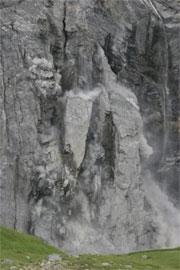 A chunk of rock the size of a skyscraper falls from the Eiger.© BRUNO PETRONI/AP/EMPICS
A chunk of rock the size of a skyscraper falls from the Eiger.© BRUNO PETRONI/AP/EMPICSThe Eiger, Switzerland's most infamous mountain, is traditionally best known for the challenge of ascending its north face. But it gained fame in another way last week when a huge chunk fell from its eastern flank, triggering claims that climate change has been implicated in yet another high-profile natural event.
Geologists predicted the rockfall last month, after noting that large cracks were working their way into the mountain's side. The crash finally came on 13 July: Swiss rescue services estimate that some 700,000 cubic metres of rock — the size of a large skyscraper— have tumbled into the valley below.
Tourists have flocked to the area, hoping to witness the mountain shedding even more rock. Geologists reckon that a further 1.3 million cubic metres may be at risk, given the growing cracks.
Natural disaster
“Mountains are fundamentally unstable, otherwise they would just get taller and taller.”
Andrew Goudie,
University of Oxford
Such a massive collapse is certainly dramatic. But the fervour with which tourists have seized on the Eiger landslide probably owes more to the mountain's fame than to the rarity of such events, or to the possibility that climate change is affecting the mountains.
"Climate change can melt the 'glue' that holds rock together in cold environments," notes Andrew Goudie, a geographer at the University of Oxford, UK. So melting ice can, in theory, release that hold and allow gravity to peel away chunks of rock. And the glaciers in the Alps do seem to be retreating.
But there's nothing to indicate that unusually warm weather is specifically responsible for this collapse on the Eiger. And geologists are at pains to point out that such rockfalls are a natural part of the process by which mountains rise and ultimately fall. "This is just part of the mountain cycle — it would have happened anyway," says Christopher Kilburn of University College London, who studies landslides at the university's Benfield Hazard Research Centre.
"Mountains are fundamentally unstable, otherwise they would just get taller and taller," Goudie explains. "The point does come where they get too tall for their own good."
Rock and roll
Globally, between five and ten large rockfalls occur each decade. And that's just the ones geologists know about, says Kilburn — the real figure may be as high as 50, because so many of the world's mountain ranges are all but inaccessible.
The Alps were hit by a similar rockfall just two years ago, when a 75-metre-tall chunk of rock came loose in northern Italy, blocking a hikers' trail. And in 1963, a catastrophic collapse on Italy's Mount Toc wiped out the village of Longarone, claiming some 2,000 lives.
The Swiss even have a name, sturzstrom, for massive rockfalls that tumble down mountains and spread far across the terrain below.
ADVERTISEMENT
But that doesn't mean these events are entirely humdrum. One puzzling feature of these types of rockfall is their ability to travel several kilometres from the point of impact under the crumbling mountainside — farther than expected from simple models.
Some geologists argue that the sprawling effects of a sturzstrom occur because, as the rocks break apart, they trap a layer of air under them, causing a 'hovercraft' effect that carries the blanket of boulders along. Another theory is that the impact releases such enormous amounts of energy that water in the ground becomes steam, which carries the rocks. But this is little more than speculation, says Kilburn.
The Eiger event is at the bottom end of the size range where the effect can be seen, says Kilburn. Fortunately, even if all of the rock that threatens to tumble does fall, it is unlikely to cause harm — the valley beneath is empty of villages, so the mysterious ability of sturzstroms to sweep great distances isn't expected to cause a problem here.
Visit our losesfaceinmassive_roc.html">newsblog to read and post comments about this story.
University of Oxford
